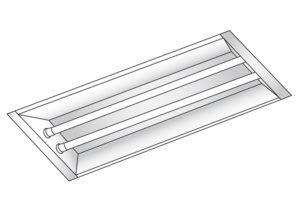Color Rendering Index (CRI) is a critical metric to consider when determining theproper specifi cations for your LED retrofi t lighting project.
Color rendering describes how a light source makes the color of an object appear to human eyes and how well subtle variations in color shades are revealed.
CRI is a numerical scale (0 to 100) used in lighting to indicate how a light source will makethe color of an object appear to human eyes. The higher the number, the better the color rendering ability. The sun, for instance, has a CRI of 100.
Light sources with a CRI of 85 to 90 are considered good at color rendering. Light sources with a CRI of 90 or higher are excellent at color rendering and should be used for tasks requiring the most accurate color discrimination.

CRI = 51

CRI = 80

CRI = 90
It is important to note that CRI is independent of color temperature (represented by the Kelvin, K scale). Examples: A 2700K (warm) color temperature incandescent light source has a CRI of 100. One 5000K (daylight) color temperature fluorescent light source has aCRI of 75 and another with the same color temperature has a CRI of 90.
When representing the true color of objects is critical, excellent CRI can make all the difference:
Retail
In any retail presentation, the merchandise, whether it is ready-to-wear or ready-to-eat, must be displayed in a well-lit environment with the true color of the goods elevating theappeal and attraction. In a fashion presentation, merchandisers carefully match items to encourage the upsell and as they match the tie to the jacket to the shirt. If then, the merchandise is presented under lighting that has a poor CRI, all the merchandisers effort is minimized by colors that appear dull and muddied. Clearly, how well the merchandise is lit has a direct impact on how well it sells.
A practical light source characterized as having good color-rendering properties should never disappoint the consumer nor proprietor of a retail store, no matter what is being sold (e.g., fruits, yarn, furniture) or what objects happen to enter the store (e.g., suits and dresses or skin and hair types).- Guide to Light and Color in Retail Merchandising, Alliance forSolid State Illuminati on Systems and Technologies, 2010.
Industrial-/Warehouse
A well-lit manufacturing or industrial plant provides the safest of environments as workers interact with machines, often in an accelerated manner, where any slip up caused by shadowing or insufficient light can have serious consequences. However, it is not simply a matter of increasing wattage, but improving CRI. In fact, when the lighting has a high CRI, the space will appear very well lit, even with less light. The combination of increased safety and improved efficiency is a win-win for an industrial environment.
In warehouses, the ability to efficiently pick and ship merchandise is critical to success. Any time the process is slowed by shadows on shelving or low light conditions that prevent workers from correctly seeing labels or SKUs, fewer shipments go out the door and fewerdollars come in. With proper CRI, all items can be seen clearly and eliminate the need forflashlights or helmet lamps to make up for poor CRI.
When color rendering is inaccurate or inconsistent, certain tasks can become more diffi cult, such as when fast and accurate assembly requires color discrimination (e.g., wiresor symbols) or for quality inspection or a paint job, or when exposed color is used to flag missing parts. Problems can include inconsistent decisions made by inspectors when different lamps are used at different workstations, or slower or incorrect employee performance because of an inappropriate lamp used throughout. Lighting Industrial Environments, Joy M. Ebben, Ph.D, CPE
Parking Garages
CRI comes into critical play in parking garages where customer safety and overall facilitysecurity are key factors in how safe people feel in a garage. If the garage is dull with abundantshadows, walking will feel unsafe and driving will feel tentative as shadows and low lightlevels force the drivers sight to adjust all too often and not see critical features that couldlead to accidents. But simply improving light levels can have a similarly debilitating effect on drivers by making the environment too glaring and bright. With proper CRI, the facility will appear well-lit, not over-lit and the true color of vehicles will be represented, much to the delight of a customer having difficulty finding their car.
When lighting a parking garage,it is important to tailor light level to location to improve visual clarity, ease eye strain, and increase safety. Lamps with higher CRI render colors moreaccurately and enable a driver to better distinguish between features and colors within thegarage as opposed to casting both pedestrians, vehicles, and walls in the same poor quality light.- Lighting Safety for Parking Garages, Allison Kelley
ThinkLites CRI across the entire product range is an industry-leading 93. That compares most favorably to ballast compatible retrofit LED tubes and replacement fixtures that off er CRI in the range of 80-83. ThinkLite is the only company that provides true CRI that nearly rivals the sun!





Leave a Reply
Your email is safe with us.
You must be logged in to post a comment.